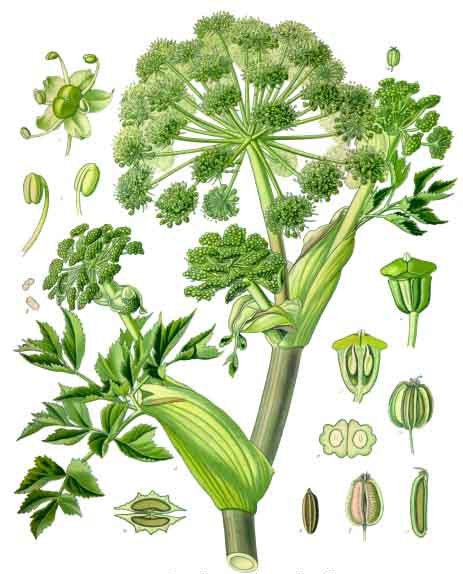- Garden Angelica
Taxobox
name = Garden Angelica

image_width = 240px
regnum =Plant ae
divisio = Magnoliophyta
classis =Magnoliopsida
ordo =Apiales
familia =Apiaceae
genus = "Angelica "
species = "A. archangelica"
binomial = "Angelica archangelica"
binomial_authority = L. [cite web
url=http://www.ars-grin.gov/cgi-bin/npgs/html/taxon.pl?3415
title=Angelica archangelica information from NPGS/GRIN
publisher=www.ars-grin.gov
accessdate=2008-03-03
last=
first=]Garden Angelica ("Angelica archangelica";
syn. "Archangelica officinalis" Hoffm., "Archangelica officinalis" "var." "himalaica" C.B.Clarke) is abiennial plant from the umbelliferous familyApiaceae . Alternative English names are "Holy Ghost, Wild Celery", and "Norwegian angelica"During its first year it only grows leaves, but during its second year its fluted stem can reach a height of two meters (or six feet). Its leaves are composed of numerous small leaflets, divided into three principal groups, each of which is again subdivided into three lesser groups. The edges of the leaflets are finely toothed or serrated. The flowers, which blossom in July, are small and numerous, yellowish or greenish in colour, are grouped into large, globular umbels, which bear pale yellow, oblong fruits. Angelica only grows in damp soil, preferably near rivers or deposits of water. Not to be confused with the toxic [http://plants.usda.gov/java/profile?symbol=PASA2 Pastinaca sativa, or "Wild Parsnip"] .
"Angelica archangelica" grows wild in
Finland ,Sweden ,Norway ,Denmark ,Greenland , theFaroe Islands andIceland , mostly in the northern parts of the countries. It is cultivated inFrance , mainly in theMarais Poitevin , a marsh region close toNiort in the départmentDeux-Sèvres .Usage/History
From the
10th century on, angelica was cultivated as avegetable andmedicinal plant , and achieved great popularity inScandinavia in the12th century and is still used today, especially in Sami culture. A flute-like instrument with a clarinet-like sound can be made of its hollow stem, probably as a toy for children. Linnaeus reported that Sami peoples used it inreindeer milk, as it is often used as a flavoring agent.In 1602, angelica was introduced in
Niort , which had just been ravaged by the plague, and it has been popular there ever since. It is used to flavourliqueur s oraquavit s (e.g. Chartreuse,Bénédictine ,Vermouth andDubonnet ),omelette s andtrout , and asjam . The long bright green stems are also candied and used as decoration.Angelica is unique amongst the
Umbelliferae for its pervading aromatic odour, a pleasant perfume entirely different fromFennel ,Parsley ,Anise ,Caraway orChervil . One old writer compares it to Musk, others liken it to Juniper. Even the roots are fragrant, and form one of the principal aromatics of European growth - the other parts of the plant have the same flavour, but their active principles are considered more perishable.Angelica contains a variety of chemicals which have been shown to have medicinal properties. Chewing on angelica or drinking tea brewed from it will cause
local anesthesia , but it will heighten the consumer'simmune system . It has been shown to be effective against various bacteria, fungal infections and even viral infections.Fact|date=August 2007The
essential oil of the roots of "Angelica archangelica" contains β-terebangelene, C10H16, and otherterpene s; the oil of the seeds also contains β-terebangelene, together with methylethylacetic acid and hydroxymyristic acid.Angelica seeds and angelica roots are sometimes used in making
absinthe .A seeds of a Persian spice plant known as
Golpar (Heracleum persicum) are often erroneously labeled as "angelica seeds." True angelica seeds are rarely available from spice dealers.Etymology
Archangelica comes from the Greek word "arkhangelos" (=arch-angel), due to the myth that it was the angel
Gabriel who told of its use asmedicine .In Finnish it is called "väinönputki", in Sami "fádnu", "boska" and "rássi", in English "garden angelica", in German "arznei-engelwurz", in Dutch "grote engelwortel", in Persian "gol-par", in Swedish "kvanne", in Norwegian "kvann", in Danish "kvan" and in Icelandic it has the name "hvönn".
References
*
External links
* [http://www.efloras.org/florataxon.aspx?flora_id=110&taxon_id=220000737 eFloras: "Angelica archangelica"]
* [http://fxcuisine.com/default.asp?Display=91 Candied Angelica Archangelica Stems Pie - step-by-step illustrated recipe in English]
* [http://sun.ars-grin.gov:8080/npgspub/xsql/duke/plantdisp.xsql?taxon=84 "Angelica archangelica" List of Chemicals (Dr. Duke's)]
Wikimedia Foundation. 2010.
